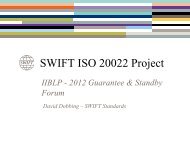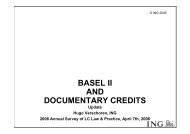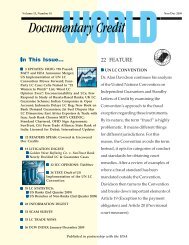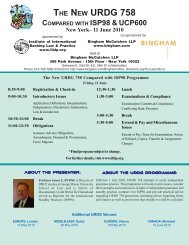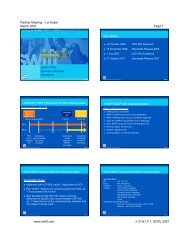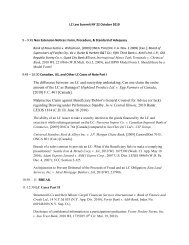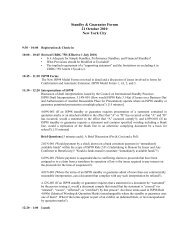FEATURE - The Institute of International Banking Law & Practice
FEATURE - The Institute of International Banking Law & Practice
FEATURE - The Institute of International Banking Law & Practice
Create successful ePaper yourself
Turn your PDF publications into a flip-book with our unique Google optimized e-Paper software.
<strong>FEATURE</strong><br />
Panelists noted that if the<br />
beneficiary is a state agency, an<br />
individual bank might have no<br />
ability to insist that language<br />
be changed. With this in mind,<br />
what can banks do to get these<br />
unsatisfactory formats<br />
changed Banks need to have<br />
the state legislators change the<br />
forms. IIBLP has <strong>of</strong>fered to try<br />
and assist with this process.<br />
Another perceived<br />
troublesome trend involves<br />
applicants taking original<br />
standby letters <strong>of</strong> credit to<br />
closings and later returning<br />
the credits, trying to cancel<br />
them. One delegate mentioned<br />
that the issuing bank has little<br />
choice but to chase the<br />
beneficiary for cancellation if<br />
the original is not required for<br />
presentation as the beneficiary<br />
may have gotten a copy.<br />
One panelist recalled a court<br />
case where a letter <strong>of</strong> credit<br />
had been returned to the<br />
issuing bank without a cover<br />
letter and the issuing bank<br />
cancelled the credit. <strong>The</strong><br />
beneficiary then drew and<br />
claimed the credit has been<br />
returned for safekeeping. <strong>The</strong><br />
beneficiary won the case.<br />
One banker explained that<br />
in his bank’s letter <strong>of</strong> credit<br />
application, there is language<br />
stating that if the applicant<br />
returns the original credit to<br />
the bank, the bank cannot<br />
cancel the credit without the<br />
beneficiary’s consent. He<br />
added that occasionally his<br />
bank will <strong>of</strong>fer an indemnity<br />
for large customers.<br />
If a letter <strong>of</strong> credit is a bid<br />
bond, then one panelist<br />
pointed out that the issuing<br />
bank can determine if the bid<br />
has been awarded or not. If<br />
the purpose is for a closing,<br />
then the lender can take the<br />
letter <strong>of</strong> credit to the closing<br />
rather than delivering the<br />
credit to the applicant.<br />
<strong>The</strong> next trend discussed<br />
was non-extension notices<br />
under standby LCs. A<br />
particularly problematic<br />
situation is finding evidence<br />
that the non-extension notice<br />
was sent when there has been<br />
a bank merger and the file<br />
[from a predecessor bank]<br />
cannot be located. Some banks<br />
have a special place where<br />
they keep these files with a<br />
“no destroy” instruction.<br />
Some years ago in the US in<br />
the face <strong>of</strong> California’s reinsurance<br />
fund crises, one<br />
panelist remembers that a<br />
California politician directed<br />
her state <strong>of</strong>ficials to draw on<br />
every standby letter <strong>of</strong> credit<br />
and make banks prove they<br />
had sent notices.<br />
Beneficiaries would have a<br />
problem knowing whether or<br />
not credits are open. Even if a<br />
beneficiary has not received a<br />
non-extension notice, it still<br />
asks for affirmation that the<br />
credit is open. One delegate<br />
suggested that perhaps<br />
legislation is needed that<br />
mandates that there is a final<br />
expiration date <strong>of</strong> ten years<br />
after issuance. At that point,<br />
the credit would be dead no<br />
matter what. Other<br />
participants cautioned against<br />
sending a non-extension notice<br />
as an amendment.<br />
Moving to the next<br />
troublesome trend, one<br />
panelist cited the increasing<br />
number <strong>of</strong> standby draws, a<br />
by-product <strong>of</strong> the struggling<br />
economy. She noted that when<br />
requiring a copy <strong>of</strong> a court<br />
order or a judgment under a<br />
credit subject to UCP600, an<br />
issuing bank must be very<br />
specific on what it wants to<br />
see. ISP98 Rule 4.19 gives<br />
guidance on what an issuing<br />
bank should consider<br />
requiring.<br />
Another stiff challenge<br />
banks are facing is compliance<br />
with government regulations.<br />
Banks are trying to interpret<br />
what the regulations mean<br />
because they are not always<br />
clear. As banks deal with this<br />
added dimension, it was<br />
pointed out that banks need to<br />
reexamine their pricing to<br />
determine if it adequately<br />
reflects the increased cost <strong>of</strong><br />
compliance.<br />
Panelists briefly referenced<br />
some initiatives. A joint effort<br />
is underway between the<br />
Bankers’ Association for<br />
Finance and Trade (BAFT) and<br />
the <strong>International</strong> Financial<br />
Services Association (IFSA) on<br />
how to interpret anti-money<br />
laundering regulations. A<br />
document based on the Bank<br />
Secrecy Act/Anti-Money<br />
Laundering Examination<br />
Manual issued in 2007 by the<br />
14 Documentary Credit World ■ June 2008




